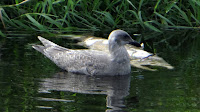 |
| Gull with Chinook salmon |
It was clearly a male, as evidenced by the noticeable ‘kype’ located at the tip of the lower jaw. This is a hook-like secondary sex characteristic which develops in some male salmonids prior to the spawning season. I estimated its size as about three feet in length.
 As I drew closer, I noticed a couple of gulls circling overhead. One landed in the water and swam over to the salmon. After inspecting it for a few moments, it sank its beak deep into the eye socket area, as I snapped off a few photos.
As I drew closer, I noticed a couple of gulls circling overhead. One landed in the water and swam over to the salmon. After inspecting it for a few moments, it sank its beak deep into the eye socket area, as I snapped off a few photos.
The gull appeared to me to be an immature glaucous-winged gull. This species is very common in our area and takes four years to become an adult. In the immature phase, the feather coloration is an admixture of cream-colored white and a mottled tan, with a black beak.
 The gull continued to paddle along beside the salmon and occasionally peck at it. After observing the two for a while longer, I finally decided to continue on my way, leaving nature to take its inevitable course.
The gull continued to paddle along beside the salmon and occasionally peck at it. After observing the two for a while longer, I finally decided to continue on my way, leaving nature to take its inevitable course.Story and Photos by John Reinke
No comments:
Post a Comment